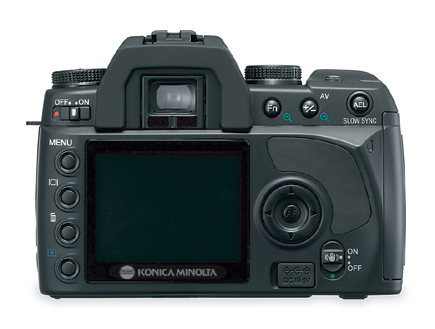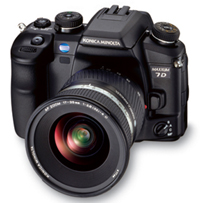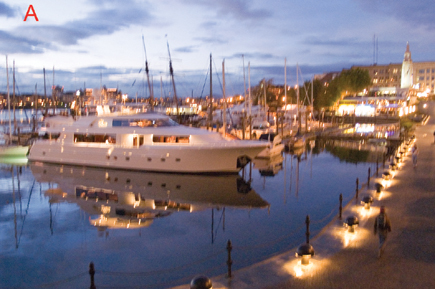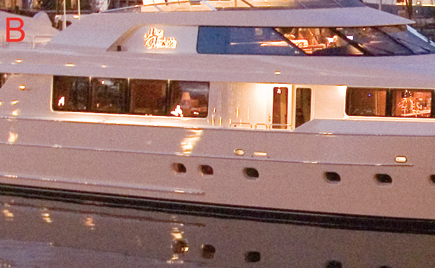Konica Minolta’s Maxxum 5D; Compact, Affordable 6-Megapixel Digital SLR With Built-In Anti-Shake (Stabilizer) System
PROS
· Oversized LCD monitor, ease of basic use, and great versatility
· Anti-Shake system provides effective stabilization with most Maxxum
lenses
· Quick response, fast 3 fps framing rate, and competitive burst depth
· Excellent image quality; digital noise and JPEG artifacts are very well
controlled
CONS
· Slightly larger/heavier than some competitors
· Some of the numerous menu items are complicated and not all are well
explained in the instructions
· At 6 megapixels, resolution is lower than with some competing model
 |
The second digital SLR to incorporate the Anti-Shake system that provides Image
Stabilization with virtually all Maxxum lenses, the Maxxum 5D is a relatively
compact, lightweight model. Roughly 22 percent smaller and 6 oz lighter than
the more rugged Maxxum 7D, it also sports fewer analog controls for greater
apparent simplicity. More importantly perhaps, the 5D sells for $200 (street
price) less, in spite of a recent 7D price reduction.
Even so, this is certainly not a stripped-down model intended only for snapshooting.
In fact, the 5D is a very fast, versatile digital SLR that produced excellent
image quality while I was shooting stock in British Columbia, Canada. It also
includes most 7D capabilities plus some new features and employs the same technology.
The primary differences between the two models are listed in our comparison
chart for quick reference.
 |
|
|
Design And Features
Compared to some other models in its price range, this is a moderately large/hefty
camera with an oversized (rubberized) handgrip; it should be adequately rugged
for most potential buyers. The huge 2.5" LCD monitor offers a real advantage
over the more typical smaller screens. While the monitor's resolution
is not particularly high, it's certainly adequate and competitive in the
sub-$800 category. There's no need for a secondary data panel, because
the color monitor displays all data (with oversized numerals) in addition to
image playback. The new roof-mirror penta-prism, plus an Acute Matte screen,
combine to provide a bright view, with just enough magnification to prevent
a "tunnel-vision" effect.
Because some first-time digital SLR buyers are intimidated by a mass of analog
controls, the 5D sports fewer buttons, dials, and switches than the 7D. Surprisingly,
the many White Balance (WB) options are now accessed with a large knob; that
control could have been dedicated to more frequently needed features. To minimize
the need for hunting and pecking through the vast electronic menu, the 5D is
equipped with a new [Fn] button for access to a submenu with four frequently
needed functions (plus the many Color modes). While some of the menu items are
complicated, I found the 5D just as quick, easy, and convenient to use as the
most basic digital SLR in other respects.
Like the 7D, the 5D employs Konica Minolta's latest image processor, CxProcess
III, for high-definition, natural-looking images and pleasing skin tones. The
processor's Advanced LSI engine assures great speed and responsiveness.
However, because of reduced buffer memory, the new camera cannot shoot as many
frames in a single burst. Frankly, that's really not a problem when using
a fast CompactFlash card. During testing, I found that the 5D could capture
10 Large/Fine JPEGs in 3.5 seconds or six Large/Extra Fine JPEGs in 2 seconds;
afterward, the camera kept firing although the framing rate slowed noticeably.
In my estimation, this performance level will satisfy most photo enthusiasts.
The 5D is quick in other respects, too, with 1 second start up time. In most
outdoor situations, I found that the camera set focus and captured the image
almost instantly, in about 1/3 sec, great for candid picture taking and street
photography. Continuous autofocus performance was quite fast, too, except in
low light, making the camera suitable for shooting amateur sporting events in
daylight. Indoors, the autofocus system was quick and reliable with static subjects;
in very dark locations; I needed to use flash, with the focus-assist feature,
as with virtually any camera.
Evaluation: This may not be the best-looking digital SLR in
the world but its large controls, oversized handgrip, and 2.5" LCD screen
(with large data read-outs) make it convenient to operate. The 5D targets the
entry-level buyer so it's simple to use, particularly with one of the
subject-specific Programs that provide "intelligent" automation.
And yet, the 5D should satisfy many experienced shooters as well, because it
includes nearly every capability that they demand. Anyone with digital camera
experience should be able to start shooting without opening the Owners Manual.
Still, it's worth spending an hour reviewing the instructions to fully
appreciate the many menu items for modifying camera operation and the appearance
of your images.
Maxxum 5D Vs. Maxxum 7D
Employing the same technology as the Maxxum 7D, including the award-winning
stabilizer that shifts the entire CCD module for camera shake compensation,
the Maxxum 5D is similar in many other respects as well. While it does not include
all 7D features, the newer model offers some new capabilities that make it more
suitable for a broader variety of experience levels. After an extensive comparison
of the Specifications lists, I compiled the following chart of the primary differences.
Note that some favor the 7D, while others make the 5D more desirable.
 |
 |
|
| Feature | Mannum 5D | Maxxum 7D |
| Construction | Mostly glass-fiber plastics; steel lens mount | More rugged; many magnesium-alloy parts |
| 2.5" LCD Monitor | 115,000 pixel resolution | Higher 207,000 pixel resolution |
| Penta-Prism | Roof mirror | All glass |
| Viewfinder | 95 percent field of view; only 0.83x magnification; diopter correction, -2.5 to +1 | 95 percent field of view; 0.9x magnification; diopter correction, -3 to +1 |
| PC Cord Socket (For Studio Flash Systems) | Requires optional PCT-100 accessory | Built-in |
| White Balance Control | Unusually extensive; gains WB Bracketing and color compensating (green to magenta) feature | Extensive but missing extra options |
| Color Modes | Same as 7D but gains Black & White plus Night, Landscape, Sunset, and Portrait sRGB Color modes | Two sRGB plus Adobe RGB options |
| Operating Modes | P, A, S, M plus five subject-specific Program modes | P, A, S, M |
| AE Bracketing And Exposure Compensation | AEB: Three frames at 0.3 or 0.7 EV increments; EC: from -2 to +2 EV in 0.3 EV steps |
AEB: Three or five frames in 0.3 or 0.5 EV; EC: -3 to +3 EV in 0.5 EV steps or -2.0 to +2.0 EV in 0.3 EV steps |
| (Built-In) Flash Coverage | Suitable for lenses as short as 18mm | Narrower; suitable for 24mm or longer lenses |
| Burst Depth | Five raw or nine Large/Extra Fine JPEGs | Nine raw or 12 Large/Extra Fine JPEGs |
| Automatic Vertical Image Rotation And Enlarged Raw Image Playback | Yes | Not available; enlarged playback only for JPEGs |
| Start-Up Time | 1 second | 2 seconds |
| Included Raw Converter Software | Extremely versatile (new) DiMAGE Master Lite |
Versatile DiMAGE Viewer |
| Vertical Battery Grip | Not compatible with such accessories | Accepts optional VC-7D |
| Connectivity | USB 2.0 Full Speed (comparable to USB 1.1) | Faster USB 2.0 Hi-Speed |
| Battery Life (CIPA Standard) | 550 frames | 400 frames |
| Size/Weight | 5.1x3.6x2.6"; 20.8 oz | 5.91x4.17x3.05"; 26.8 oz |
| Street Price (Body) | $719 | $899 |
Anti-Shake Technology
Because the Anti-Shake stabilizer system has been available for over a year
in the 7D, most readers are familiar with this device. Quite different in principle
than the Optical Stabilizers used in some brands of lenses, Anti-Shake achieves
a comparable effect by shifting the camera's CCD sensor module to compensate
for camera shake. That action produces sharp images in handheld shooting at
longer shutter speeds than conventional (non-stabilized) equipment. And there's
no need to buy new lenses with stabilizing devices because Anti-Shake is effective,
with any Maxxum lens ever made, with only two exceptions: the 16mm Fisheye and
the 3x-1x Macro Zoom. (The system should also work well with many Maxxum mount
lenses of other brands.)
A five-step LED indicator in the viewfinder keeps the user informed of the extent
of Anti-Shake activity. The more of the blue LEDs that are illuminated, the
greater the amount of camera shake compensation that is ocurring. When all five
are lit, maximum CCD shift is under way.
This system is certainly useful but it's not perfect in every respect.
As Konica Minolta warns, "Anti-Shake is less effective with moving subjects
or when the camera is panned, at shutter speeds of 1/4 sec or longer, or at
short object distances [as in macro photography]." The company also recommends
turning the Anti-Shake system off when the 5D is mounted on a tripod. That's
not a drawback because there's no need for shake compensation when using
a firm support. Remember, too, that no stabilizer system can "freeze"
a moving subject; fast shutter speeds are required unless you want to make photos
with motion blur for creative effects.
 |
|
 |
|
 |
|
 |
|
|

































